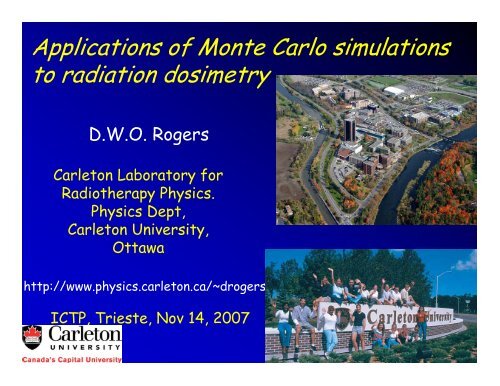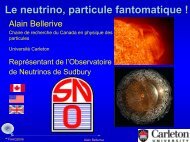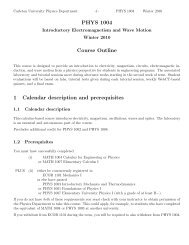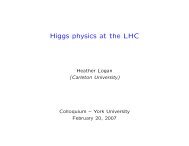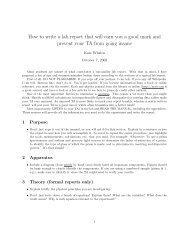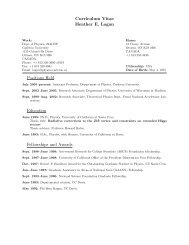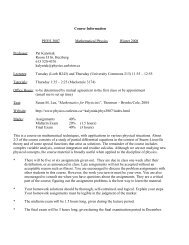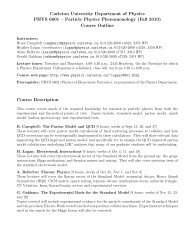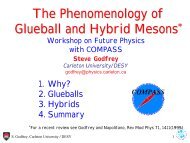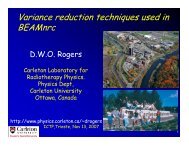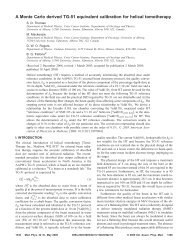Applications of Monte Carlo simulations to radiation dosimetry
Applications of Monte Carlo simulations to radiation dosimetry
Applications of Monte Carlo simulations to radiation dosimetry
Create successful ePaper yourself
Turn your PDF publications into a flip-book with our unique Google optimized e-Paper software.
<strong>Applications</strong> <strong>of</strong> <strong>Monte</strong> <strong>Carlo</strong> <strong>simulations</strong><br />
<strong>to</strong> <strong>radiation</strong> <strong>dosimetry</strong><br />
D.W.O. Rogers<br />
Carle<strong>to</strong>n Labora<strong>to</strong>ry for<br />
Radiotherapy Physics.<br />
Physics Dept,<br />
Carle<strong>to</strong>n University,<br />
Ottawa<br />
http://www.physics.carle<strong>to</strong>n.ca/~drogers<br />
ICTP, Trieste, Nov 14, 2007<br />
1
Papers in PMB and Med Phys with<br />
<strong>Monte</strong> <strong>Carlo</strong> in title or abstract<br />
2/64
Radiation <strong>dosimetry</strong> in radiotherapy<br />
• primary standards<br />
– air kerma,<br />
– absorbed dose<br />
• electron & pho<strong>to</strong>n beams<br />
• beta-ray fields<br />
• clinical <strong>dosimetry</strong> pro<strong>to</strong>cols<br />
– dose in a water tank<br />
• TG51, TG61, TG43, TRS-398<br />
• radiotherapy treatment planning<br />
– dose in a (CT) patient<br />
3/64
adiation dosimeters<br />
• many types <strong>of</strong> <strong>radiation</strong> dosimeters for radiotherapy<br />
–ion chambers-the work horse for clinical reference<br />
<strong>dosimetry</strong> and air kerma primary standards<br />
– calorimeters for absorbed dose primary standards<br />
– free air chambers for x-ray air kerma standards<br />
–TLDs LiF<br />
– diodes, MOSFETS<br />
– radiographic and radiochromic films<br />
– chemical (Fricke) dosimeters<br />
<strong>Monte</strong> <strong>Carlo</strong> calculations have been<br />
used <strong>to</strong> elucidate all <strong>of</strong> these.<br />
4/64
Farmer ion chamber<br />
Ion chambers<br />
from John McCaffrey, NRC<br />
5/64
Cavity theory: s<strong>to</strong>pping-power ratios<br />
Relates dose in cavity <strong>to</strong> dose in medium.<br />
med<br />
gas<br />
sprs are fundamental <strong>to</strong><br />
-<strong>dosimetry</strong> pro<strong>to</strong>cols<br />
-primary standards<br />
6/64
What is (L/ρ)?<br />
A Spencer-Attix spr - s<strong>to</strong>pping-power ratio<br />
7/64
Dosimetry in a water tank<br />
P wall , P gr , P fl , P cel all 1% or less effects<br />
-major variation comes from spr<br />
for complete definitions <strong>of</strong> P wall etc see<br />
http://www.physics.carle<strong>to</strong>n.ca/~drogers/pubs/papers/ss96.pdf<br />
8/64
Electron beam depth-dose curve<br />
12 MeV<br />
9/64
sprs in electron beams<br />
Ding et al, Med Phys 22(1995) 489-501<br />
10/64
Realistic electron beam sprs<br />
BEAM code used <strong>to</strong> simulate realistic accelera<strong>to</strong>r<br />
beams<br />
Ding et al Med Phys 22 (1995)489<br />
11/64
Effects <strong>of</strong> realistic sprs<br />
Ding et al MP 22(1995)489<br />
12/64
How <strong>to</strong> use realistic sprs<br />
David Burns noted:<br />
changing d ref simplifies everything.<br />
d ref = 0.6 R 50 - 0.1 (cm)<br />
The basis <strong>of</strong> electron beam <strong>dosimetry</strong> in<br />
IAEA TRS-398 and AAPM TG-51 clinical pro<strong>to</strong>cols<br />
Burns et al MP 23(1996)383<br />
13/64
Realistic sprs: d ref=0.6R 50 - 0.1<br />
Burns et al MP 23(1996)383<br />
14/64
Pho<strong>to</strong>n beams: specifying beam quality<br />
• NAP -nominal accelerating potential<br />
• %dd(10) -percentage depth dose at 10 cm depth<br />
in a 10x10 cm2 field on surface at SSD<br />
100 cm<br />
• %dd(10) X -the pho<strong>to</strong>n component <strong>of</strong> %dd(10)<br />
(i.e., ignoring electron contamination)<br />
• TPR20 10 -ratio <strong>of</strong> absorbed doses at depths 20<br />
and 10 cm in a water phan<strong>to</strong>m, measured<br />
with a constant source-chamber<br />
distance <strong>of</strong> 100 cm and a field size <strong>of</strong><br />
10x10 cm2 TG-51<br />
TRS-398<br />
at the plane <strong>of</strong> the chamber<br />
15/64
sprs for pho<strong>to</strong>n beams<br />
filled: heavily filtered<br />
open: lightly filtered<br />
Kalach and Rogers 30 (2003) 1546-1555<br />
16/64
sprs for pho<strong>to</strong>n beams<br />
filled: heavily filtered<br />
open: lightly filtered<br />
Kalach and Rogers 30 (2003) 1546-1555<br />
17/64
What happens without a flattening filter?<br />
For IMRT, flattening<br />
filter is not needed<br />
(Titt et al, Med Phys<br />
33(2006) 3270).<br />
A single fit handles<br />
both sets <strong>of</strong> beams<br />
using %dd(10) x .<br />
Major effect is on<br />
%dd(10) x due <strong>to</strong><br />
non-flat beams<br />
Xiong and Rogers, in prep, 2007<br />
Based on full BEAM <strong>simulations</strong>.<br />
18/64
Two sets <strong>of</strong><br />
k Q values will<br />
be needed,<br />
one for with<br />
flattening<br />
filters, one<br />
for machines<br />
without them.<br />
Flattening filter free: TPR<br />
19/64
Summary: pro<strong>to</strong>col <strong>dosimetry</strong><br />
• the major quantity which varies in pro<strong>to</strong>col<br />
<strong>dosimetry</strong> is the s<strong>to</strong>pping power ratio<br />
– hence the discussion <strong>of</strong> it<br />
• but other aspects <strong>of</strong> pro<strong>to</strong>cols such as TG-51 and<br />
TRS-398 which are based on MC calculated values<br />
–Pwall for plane parallel chambers in Co-60 beams<br />
–Pcel for aluminium electrodes<br />
– relationship between I50 and R50 in e- beams<br />
• plus on-going research on other aspects<br />
–Pwall for all beams, Prepl, effective point <strong>of</strong><br />
measurement<br />
20/64
Primary standards <strong>of</strong> air-kerma in Co-60<br />
Primary standards in Co-60 beams are based on<br />
cavity ion chambers and S-A cavity theory<br />
D gas D wall /D gas D air /D wall<br />
for complete definitions see<br />
http://www.physics.carle<strong>to</strong>n.ca/~drogers/pubs/papers/fundamentals_ss90.pdf<br />
21/64
How accurately can we calculate ion<br />
chamber response?<br />
Fano cavity chamber, - walls and gas the same material<br />
(assume graphite) with a density ratio <strong>of</strong> about 1000.<br />
- establish kerma <strong>to</strong> graphite in a parallel 60 Co beam.<br />
Fano’s theorem => no fluence correction (traditionally<br />
ignored, but in principle needed). All other K = 1.00<br />
ie we can check our D gas calculation<br />
22/64
How accurately can we calculate ion<br />
-cover <strong>of</strong><br />
EGSnrc<br />
manual<br />
-against<br />
own cross<br />
sections<br />
-ESTEPE<br />
is max<br />
fractional<br />
step size<br />
chamber response? (cont)<br />
This is the <strong>to</strong>ughest test I know for any<br />
electron-pho<strong>to</strong>n <strong>Monte</strong> <strong>Carlo</strong> code<br />
23/64
How accurately can we calculate ion<br />
against<br />
measured<br />
data<br />
chamber response? (cont)<br />
Kawrakow & Rogers, MC2000, p135 based on data <strong>of</strong><br />
Nilsson et al, IAEA Proceedings, 1988<br />
24/64
K wall: attenuation and scatter<br />
K air eqn ignores attenuation and scatter in chamber walls<br />
<strong>Monte</strong> <strong>Carlo</strong> K wall scores<br />
D gas without / D gas with scatter and attenuation<br />
or<br />
Or regenerate interacting pho<strong>to</strong>ns &<br />
ignore scattered pho<strong>to</strong>ns<br />
25/64
K wall: non-linear extrapolation<br />
Rogers & Bielajew, PMB 35 (1990) 1065<br />
26/64
Some measured confirmations <strong>of</strong> MC K wall<br />
rotate the<br />
chamber in Co-60<br />
response*K wall<br />
=response/A wall<br />
should be constant<br />
graphite walled chamber at NRC<br />
27/64
If A wall is<br />
correct,<br />
R/A wall should<br />
be constant.<br />
It is, within<br />
0.3% despite<br />
8% variation.<br />
(residual 0.3%<br />
is a K an effect)<br />
Response vs angle <strong>of</strong> Mark IV<br />
McCaffrey et al PMB 49(2004) 2491<br />
28/64
adial<br />
PTB/OMH: cylindrical chamber<br />
axial<br />
45<br />
axis <strong>of</strong><br />
rotation<br />
measured response<br />
vs wall thickness.<br />
Should all<br />
extrapolate <strong>to</strong><br />
same value.<br />
Only the calculated K wall correction gave a constant response<br />
Büermann et al PMB 48 (2003) 3581<br />
29/64
K an: axial non-uniformity<br />
Bielajew developed an analytic theory <strong>to</strong> account for point<br />
sources not parallel beams (PMB 35(1990)501 & 517)<br />
A brute force MC calculation with a parallel beam or a point<br />
source, confirms the analytic theory.<br />
The corrections are all very small for Co-60 sources at 1 m<br />
from typical chambers<br />
30/64
Revision <strong>of</strong> air-kerma standards<br />
Using EGSnrc calculated K wall and K an values, revise the<br />
reported values<br />
Rogers and Treurniet, 1999 (NRC Report<br />
PIRS-663)<br />
extending work <strong>of</strong><br />
Bielajew and Rogers, PMB 37(1992)1283<br />
31/64
Revision <strong>of</strong> air-kerma standards (cont)<br />
Note: the BIPM<br />
baseline moved up<br />
by 0.3%.<br />
------<br />
<strong>Monte</strong> <strong>Carlo</strong> =><br />
world’s air kerma<br />
standards<br />
increased 0.8%<br />
(double stated<br />
uncertainty)<br />
Rogers & Treurniet<br />
1999 NRC Report<br />
32/64
How accurate are calculations?<br />
If we are going <strong>to</strong> use <strong>Monte</strong> <strong>Carlo</strong> calculated fac<strong>to</strong>rs, we<br />
need <strong>to</strong> know their uncertainty<br />
How sensitive are they <strong>to</strong>:<br />
-algorithm/computer code used<br />
-cross sections<br />
-spectrum used<br />
-size <strong>of</strong> source<br />
Rogers & Kawrakow Med Phys 30 (2003)521<br />
33/64
Calculated response <strong>of</strong> NRC 3C chamber<br />
34/64
K wall for NRC 3C<br />
35/64
(L/ρ) for different algorithms<br />
EGSnrc<br />
36/64
K wall vs incident spectrum<br />
37/64
K an vs incident spectrum<br />
38/64
spr vs incident spectrum<br />
39/64
K an for 3C vs source radius<br />
40/64
Uncertainty estimates (%)<br />
spr K wall<br />
K an K comp<br />
Stats
Verification <strong>of</strong> cavity theory?<br />
Can <strong>Monte</strong> <strong>Carlo</strong> verify the accuracy <strong>of</strong> cavity theory?<br />
EGSnrc can calculate D gas <strong>to</strong> 0.1%<br />
(pro<strong>of</strong>: Fano cavity calculations)<br />
Cavity theory assumes that pho<strong>to</strong>n<br />
interactions in the cavity do not occur<br />
But Ma and Nahum showed they did.<br />
PMB 36(1991)413<br />
So does cavity theory hold for Ir-192 or lower energy<br />
pho<strong>to</strong>n beams?<br />
42/64
Accuracy <strong>of</strong> Spencer-Attix cavity theory<br />
spectrum<br />
Another thought/computational experiment<br />
For a parallel beam incident on a<br />
stemless chamber filled with dry air<br />
CAVRZnrc<br />
SPRRZnrc<br />
DOSRZnrc<br />
EGSnrc<br />
CAVRZnrc<br />
43/64
Accuracy <strong>of</strong> Spencer-Attix cavity theory<br />
Only this<br />
good<br />
because<br />
graphite<br />
and air so<br />
similar.<br />
Calculations used ∆ = 10 keV for spr. Using<br />
larger values brings value within 0.1% <strong>of</strong> unity<br />
Borg et al, Med Phys 27(2000)1804<br />
44/64
The use <strong>of</strong> silicon diode detec<strong>to</strong>rs<br />
• a common assumption is that diode detec<strong>to</strong>rs<br />
measure dose directly<br />
– ie no spr correction etc<br />
• but sprs actually change quite a bit as the beam<br />
quality changes<br />
• Why don’t we need <strong>to</strong> correct for this?<br />
45/64
model <strong>of</strong> diode detec<strong>to</strong>r (Scanditronix EFD)<br />
McKerracher and Thwaites<br />
Radioth Oncol 79(06) 348<br />
Wang Med Phys 34 (2007) 1734<br />
46/64
water/silicon s<strong>to</strong>pping powers are not constant<br />
calculate ratio<br />
<strong>of</strong> dose in small<br />
active region <strong>of</strong><br />
diode detec<strong>to</strong>r<br />
isolated from<br />
rest <strong>of</strong> detec<strong>to</strong>r<br />
<strong>to</strong> dose <strong>to</strong> water<br />
at same location.<br />
Use CSnrc which<br />
uses correlated<br />
sampling<br />
Wang Med Phys 34 (2007) 1734<br />
47/64
dose water/dose silicon active region<br />
Wang Med Phys 34 (2007) 1734<br />
48/64
effect <strong>of</strong> backscatter from rest <strong>of</strong> chip<br />
Wang Med Phys 34 (2007) 1734<br />
49/64
diode response at d max vs field size<br />
mostly a<br />
change in spr<br />
effect as<br />
d max changes<br />
Wang Med Phys 34 (2007) 1734<br />
50/64
Summary re diode detec<strong>to</strong>rs<br />
• diodes measure dose directly within +-1% as a<br />
function <strong>of</strong> depth and beam quality in electron<br />
beams<br />
–one exception - small radius electron beams<br />
• the silicon backing <strong>of</strong> the active region and the<br />
epoxy play an important role in the flat<br />
response<br />
51/64
P TP: the pressure-temperature correction<br />
t<br />
ion<br />
chamber<br />
e-<br />
for ion chambers<br />
PTP is constructed so<br />
independent <strong>of</strong> ρ<br />
So E dep (ρ) is proportional <strong>to</strong> the density ρ.<br />
E dep (ρ ο ) is independent <strong>of</strong> the density ρ.<br />
52/64
e-<br />
ion<br />
chamber<br />
P TP (cont)<br />
What happens if the electron<br />
does not cross the cavity?<br />
independent <strong>of</strong> ρ<br />
E dep (ρ) is no longer proportional <strong>to</strong> the density ρ.<br />
Hence the standard P TP correction fac<strong>to</strong>r may no longer work.<br />
53/64
Pressure vs. altitude<br />
54/64
NE2571 A12<br />
“A4”<br />
NRC xray<br />
moni<strong>to</strong>r<br />
• EGSnrc <strong>Monte</strong> <strong>Carlo</strong> code<br />
• cross-sections for DRY air<br />
<strong>of</strong> different densities<br />
• calculate D cav (dose <strong>to</strong> air)<br />
• standard P TP correction<br />
inherent in results<br />
• PTB catalogued spectra<br />
55/64
Thimble chamber calculations<br />
56/64
Conclusions <strong>of</strong> P TP paper I<br />
• there is a significant breakdown <strong>of</strong> the standard P TP<br />
correction for low energy pho<strong>to</strong>n beams<br />
• basic cause: e- s<strong>to</strong>pping in the cavity, not crossing<br />
• magnitude <strong>of</strong> the effect depends on:<br />
– mismatch <strong>of</strong> wall <strong>to</strong> air cross sections<br />
– fraction <strong>of</strong> dose due <strong>to</strong> pho<strong>to</strong>n interactions in the<br />
cavity air<br />
• a similar effect was reported in 2005 by the UW<br />
ADCL for well ion chambers for I-125<br />
57/64
Experiments at NRC <strong>to</strong> demonstrate the effect<br />
with Malcolm<br />
McEwen<br />
complete BEAMnrc model <strong>to</strong> give x-ray spectrum<br />
58/64
A variety <strong>of</strong> chambers studied<br />
A2 NE2571<br />
A12 NE2505<br />
C552<br />
aluminium<br />
A19<br />
C552 graphite<br />
dural, C552<br />
Kawrakow’s egs_view<br />
Calculations with cavity.cpp, using Kawrakow’s<br />
C++ geometry package & interface <strong>to</strong> EGSnrc<br />
59/64
Closed symbols:<br />
P TP corrected<br />
measured<br />
responses<br />
open symbols:<br />
calculated<br />
responses<br />
Farmer-like chambers: 60 kV<br />
60/64
CAVRZnrc<br />
uses a<br />
cylindrical<br />
model<br />
cavity.cpp<br />
includes the<br />
conical end.<br />
Effects <strong>of</strong> geometry details<br />
These geometry differences have no effect in a<br />
Co-60 beam<br />
61/64
Summary re P PT corrections<br />
• measurements confirm the calculated breakdown<br />
<strong>of</strong> the PTP correction fac<strong>to</strong>r for low-energy x-rays<br />
• EGSnrc is capable <strong>of</strong> reproducing air-kerma<br />
calibration coefficients well within 1%<br />
–NKvs beam quality curves allow quantification<br />
<strong>of</strong> the size <strong>of</strong> impurity effects<br />
• geometry details have some effects at these low<br />
energies although not at Co-60<br />
• impurities are important at low pho<strong>to</strong>n energies<br />
62/64
Summary<br />
MC techniques play a fundamental role in <strong>radiation</strong> <strong>dosimetry</strong><br />
• sprs and other corrections for ion chambers used<br />
in clinical <strong>dosimetry</strong><br />
• correction fac<strong>to</strong>rs for primary standards<br />
• verification <strong>of</strong> cavity theory accuracy<br />
• elucidation <strong>of</strong> detec<strong>to</strong>r response (eg diode)<br />
• investigation <strong>of</strong> pressure-temperature effects<br />
• and much, much more<br />
– TLDs, OSL, alanine,Fricke, well chambers,<br />
brachytherapy <strong>dosimetry</strong> etc<br />
63/64
Acknowledgements<br />
• The work described here has been done in conjunction<br />
with many colleagues, grad students and research<br />
associates, without whom it wouldn’t get done.<br />
• the various works described involved: Iwan Kawrakow,<br />
David Burns, George Ding, Guoming Xiong, Nina Kalach,<br />
Jette Borg, Alex Bielajew, John McCaffrey, Joanne<br />
Truerniet, Lilie Wang and Dan La Russa, but many more<br />
were involved in the overall project <strong>of</strong> <strong>Monte</strong> <strong>Carlo</strong> in<br />
<strong>radiation</strong> <strong>dosimetry</strong><br />
• Support from the Canada Research Chairs program and<br />
64/64


